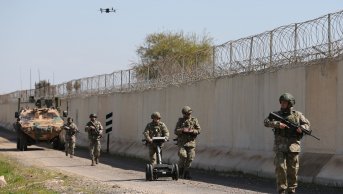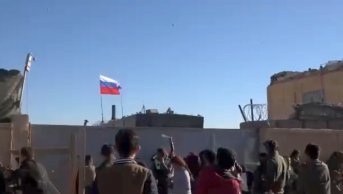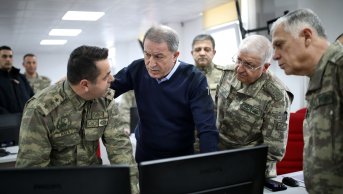Syrian Turkmens’ Military Structuring in the Context of Safe Zone Debates

The power struggle in Syria turned into a military conflict from a political and civilian strife within the first six months of the civil war. As a result of this turn, many non-hierarchical military organizations emerged, many of which act independently from each other and only control the towns and neighborhoods they are present. The struggle between the regime and the opposition continued to take place through these groups.
Syrian Turkmens constitute a part of this process. Turkmens have been in the ranks of the opposition since the beginning of the uprising and established military units in all Turkmen settlements in order to protect their own towns and villages since the central authority lost control. These military units, which have emerged especially in Latakia (Bayir-Bucak) and Aleppo, have fought under Free Syrian Army against the Assad regime. A great portion of the rural Turkmen settlements have been under control of local military units. In addition, Turkmen military units fought against the Syrian army with other armed opposition groups in city centers such as Aleppo and Homs.
The strongest Turkmen military units emerged in cities like Aleppo and Bayir Bucak where Turkmens live densely. In Latakia Province’s Bayir Bucak region, opposition forces have the control of the most of the Turkmen settlements. Due to geographical conditions and demographics of the region, the regime can only interfere with barrel bombs with aerial strikes. In Aleppo, Turkmens, who live densely through Turkish border, controlled their regions for a long time. Turkmens were in control of a 350 km long region. In addition to this, six Turkmen neighborhoods in Aleppo city center were protected by Turkmens. However, with ISIS’s getting stronger in time in northern front of the Syrian civil war, Turkmen settlements between Azaz and Jarablus began to fall under ISIS control. ISIS took over this region as a result of its offensives from Raqqa to northern Aleppo in January 2014 and all Turkmen units had to flee to Turkey. As of today, the only remaining Turkmen unit in Aleppo is Fatih’s Grandsons (Ahfad ul Fatih) and a great portion of rural Turkmen settlements is still under ISIS control.
Two developments in June 2015 brought Syrian Turkmen military units back to the agenda. First one is Tel Abyad’s taking over by Kurdish militia YPG, possibility of northern Syria’s turning into a Kurdish region, and anticipation that Kurdish groups would direct its forces to the region between Azaz-Jarablus, where Turkmens live densely, with the US aerial support. As a result of the anticipation after the first development, second development is the emergence of the debates over Turkey’s potential military interference in order to establish a safe zone in the mentioned region. In both scenarios, the question of who is going to fill the gap from ISIS in Aleppo’s Turkmen regions keeps coming up.
Turkmens have been in the ranks of the opposition since the beginning of the uprising and military units have always acted under Free Syria Army with Arab opposition. Turkmens do not want an ethnically divided Syria. In this context, neither ISIS nor Kurdish control over their region has been accepted. But, they are not able to protect their own regions with their current military structure. And their allies, FSA and Islamic Front, have not been able hold on against ISIS. However, the above mentioned two developments signal a critical change in Aleppo’s Turkmen regions in near future. Therefore, there is a need to reorganize Aleppo’s Turkmen military units and establish coordination between all Turkmen units in the region.
In this framework, a meeting took place in Gaziantep in July 2015 under the leadership of Syrian Turkmen Assembly, in which the participants were Turkmen commanders fighting on the ground, political representatives, and Turkmen civil society organizations. 150 Turkmen representatives from Aleppo, Golan, Mumbuch, Jarablus, Latakia – Bayir Bucak, Idlib, Raqqa, Tel Abyad, and Homs attended to the meeting. As a result of the talks, a decision to establish military council under Turkmen Assembly was taken in order to apply more effective ways on the ground. Seven groups located between Aleppo and Turkish border, which includes units of Fatih Sultan Mehmet, Sultan Murat, Suleyman Shah, and Ismail Shah, were decided to unite under one command. Furthermore, another decision to begin to work in order to coordinate all Turkmen units under a commandership in different regions has also been taken. Turkmens also addressed the issue how to protect themselves against ISIS and PYD.
In his speech during the meeting, the President of the Turkmen Assembly Abdurrahman Mustafa stated that “During the five year old conflict, Syrian Turkmens have failed to act united and establish strong units; and their territories have been taken away from them by ISIS and PYD, and as a result Turkmens are facing the threat of losing their homes that they can go back”. He emphasized the necessity of founding a Turkmen army in order to protect the Turkmen settlements in Aleppo in the long run against threats of ISIS and YPG. In the first phase after the meeting, the plan is increasing the level of cooperation and coordination between Turkmen units active in different locations in matters such as military transfer and weaponry support. It is stated that in case of having a successful process, the aim is turning the cooperation and coordination into a “Turkmen Army”.
As stated above, Turkmens have been fighting in the ranks of the FSA since the beginning of the uprising; they defend territorial integrity of Syria, and do not accept any sort of ethnic or constitutional partition of the country. For this reason, it is not possible for them to gather a military force to establish a Turkmen region as happened in the Kurdish example. Rather, they need an armed force to protect their settlements against outsider threats and their people against forced migration. However, in a situation where four years have passed since the beginning of the civil war, ISIS has increased its strength extremely, and YPG has obtained US aerial support, it is difficult for Turkmens to start an initiative from nothing and success in Aleppo. At this point Turkey’s interference into ISIS controlled-region between Azaz and Jarablus in order to establish a safe zone can make a change in the situation in favor of Turkmens. Thus, Turkmens can protect their region without any outsider threats and establish a military organization that can defend their regions and people against ISIS and outsider threats in the long run.










